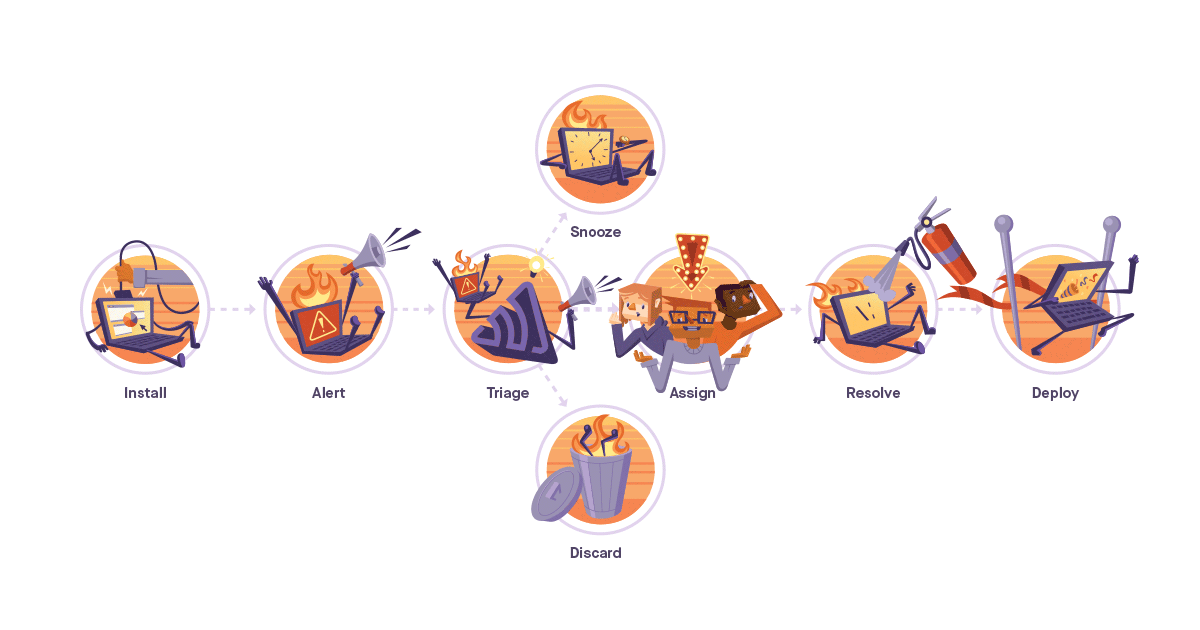The Sentry Workflow

Errors are inevitable (in life and in code), causing a lost trust from customers, lost revenue, and decreased team productivity. Instead of trying to eliminate them altogether, we should minimize the impact that these errors have on the software development process
Crashes increase churn by as much as 534%, representing a 6 increase from “average” churn rates1, based on research from tens of thousands of mobile apps representing hundreds of millions of application launches.
Users are up to 8 times less likely to use a product the next day after a crash2.
Acquiring a new customer is anywhere from five to twenty-five times more expensive than retaining an existing one.
Fred Brooks, engineer and author, explains that “we usually expect the number of bugs to be smaller than it turns out to be. Therefore testing is the most mis-scheduled part of programming. Coding is generally 1⁄6 of time.”4
Without careful attention to error management and code performance, developers can spend more time handling issues than they do writing new functional code. This is bad.
Thankfully, Sentry exists. Sentry is more than just error tracking.It’s how you maintain the quality of your code and work more efficiently with your team to improve user experience. Merging Sentry into your existing workflow — specifically the alert, triage, and resolution phases — provides the insight to help you work much more efficiently.
Download this PDF to learn how you can take advantage of the Sentry Workflow
Get in touch.
A peek at your privacy
Here’s a quick look at how Sentry handles your personal information (PII).
×Who we collect PII from
We collect PII about people browsing our website, users of the Sentry service, prospective customers, and people who otherwise interact with us.
What if my PII is included in data sent to Sentry by a Sentry customer (e.g., someone using Sentry to monitor their app)? In this case you have to contact the Sentry customer (e.g., the maker of the app). We do not control the data that is sent to us through the Sentry service for the purposes of application monitoring.
Am I included?PII we may collect about you
- PII provided by you and related to your
- Account, profile, and login
- Requests and inquiries
- Purchases
- PII collected from your device and usage
- PII collected from third parties (e.g., social media)
How we use your PII
- To operate our site and service
- To protect and improve our site and service
- To provide customer care and support
- To communicate with you
- For other purposes (that we inform you of at collection)
Third parties who receive your PII
We may disclose your PII to the following type of recipients:
- Subsidiaries and other affiliates
- Service providers
- Partners (go-to-market, analytics)
- Third-party platforms (when you connect them to our service)
- Governmental authorities (where necessary)
- An actual or potential buyer
We use cookies (but not for advertising)
- We do not use advertising or targeting cookies
- We use necessary cookies to run and improve our site and service
- You can disable cookies but this can impact your use or access to certain parts of our site and service
Know your rights
You may have the following rights related to your PII:
- Access, correct, and update
- Object to or restrict processing
- Port over
- Opt-out of marketing
- Be forgotten by Sentry
- Withdraw your consent
- Complain about us
If you have any questions or concerns about your privacy at Sentry, please email us at compliance@sentry.io.
If you are a California resident, see our Supplemental notice.